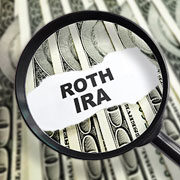Saving for retirement on a tax-advantaged basis should be on nearly everyone's financial "to do" list. By making contributions to a Roth IRA, self-employed people are using one tax-wise way to save. This is because you can take withdrawals after age 59 1/2 that are free from federal income tax, assuming you've had at least one Roth account open for more than five years. Of course, Roth contributions are nondeductible, but they are valuable because you reap tax savings on the back end of the deal.  However, if you're self-employed and fairly affluent, you may have dismissed the idea for two reasons:
However, if you're self-employed and fairly affluent, you may have dismissed the idea for two reasons:
1. You figure your income is too high to qualify for Roth contributions.
2. You figure a Roth IRA is not that attractive because you believe you're in a higher tax bracket now than you'll be in during retirement. Instead, you make maximum deductible contributions to a traditional tax deferred retirement arrangement such as a simplified employee pension (SEP) plan, solo 401(k), or a defined contribution or defined benefit Keogh plan.
In this article, we'll examine why both assumptions may be wrong and why a Roth IRA is a smart way to build a substantial federal-income-tax-free retirement fund -- even if you have another retirement plan.
Think Your Income Is Too High? You May Be Wrong
It's true that the ability to make Roth IRA contributions is phased out, or completely eliminated, if your modified adjusted gross income (MAGI) exceeds certain levels. For 2021, the phase-outs start at the amounts listed below. MAGI is the adjusted gross income (AGI) amount reported on the bottom of page one of your Form 1040 with certain add-backs that may or may not apply in your situation.
| Income Limit |
For 2021 |
| Unmarried individual MAGI phase-out range | $125,000 (up from $124,000 in 2020) |
| Married joint filer MAGI phase-out range | $198,000 (up from $196,000 in 2020) |
At first glance, these figures do make it look like a self-employed person with a robust income is unlikely to be eligible for contributions. But take another look.
A self-employed individual's modified adjusted gross income is likely to be considerably lower than the MAGI of another person who is in roughly equivalent circumstances and who is an employee. Reason: Successful self-employed taxpayers usually have hefty deductions for:
- Certain expenses incurred in the business (such as deductions for rent, an office in the home or a computer system).
- Contributions to a tax-deferred retirement plan (typically, a SEP, a defined contribution Keogh plan or a solo 401(k) plan).
- Health insurance premiums.
- The write-off for 50 percent of self-employment tax.
These deductions, along with others, are available to self-employed people and are subtracted in arriving at MAGI. Therefore, a self-employed person can have relatively high gross income from his or her business while having a much lower MAGI.
Bottom Line: Don't think you qualify for contributions to your Roth IRA? Self-employed people often do qualify without even realizing it. Tax a look at your tax deductions before you miss out.
Think a Deductible Plan is the Only Way to Go? You Could be Wrong
Clearly, it's a good idea to deduct contributions to a tax-deferred retirement plan (such as a SEP) set up for your self-employed business. However, that doesn't necessarily mean such contributions
| More Roth IRA Advantages
|
are preferable to contributing the same amounts to a Roth IRA. The best way to evaluate the issue in your situation is to look at two assumptions:
Assumption #1: You will always take the tax savings from making a deductible retirement plan contribution and either invest the money in a taxable retirement savings account or use the money to make a bigger deductible retirement plan contribution.
Assumption #2: You expect to be in a lower tax bracket during your retirement years, which means you're generally well advised to make a deductible contribution to a tax-deferred retirement plan, instead of a Roth IRA.
In real life, though, you may not be disciplined enough to follow through with the first assumption. And the second assumption can also be problematic when you consider the federal budget deficit and politics. If it turns out that you will actually pay higher tax rates during your retirement years because tax rates go up, you'll wish you had made Roth contributions when you had the chance.
Key Point: Even if both of the above assumptions are true, you should still make Roth IRA contributions if you have cash left over after making the maximum deductible contributions to a tax-deferred retirement plan. In other words, don't just do one or the other. Contribute to both!
Do you have questions about a Roth IRA, self-employed taxes, and other accounting needs? Contact us today.



